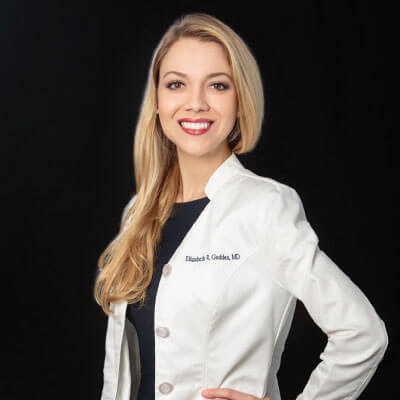We may receive a portion of sales if you purchase a product through a link in this article.
All your beauty questions—answered. Our resident dermatologist, Dr. Geddes Bruce breaks down the biggest topics in beauty, from hair loss to Botox and everything in between. Send us a DM @camillestyles with your own burning q’s and we may address it in a future column.
Say it with me: sun protection is sexy. With sunscreens for every skin type on the market—and a new class of self-tanners giving you a natural glow without having to bake in the sun—it’s easier than ever to stay protected. Face sunscreens can be tinted, reapplied over makeup, and are laden with the benefits of serums. Body sunscreens are no longer sticky and dull, but are often the final step in a bodycare routine for glowing skin. Perhaps it goes without saying, but sunscreen is one of my favorite parts of my beauty routine.
A Dermatologist Breaks Down the Biggest Sunscreen Myths
Q: I feel overwhelmed with everything I hear about sunscreen. I know I need to be wearing it every day and applying it often… but how often? And how do I make sure I’m picking the right one?
Social media has played a huge role in making sunscreen fun—and, dare I say, cool. But it can also make it seem complicated. It’s easy to feel overwhelmed given all the product options and application tips. Plenty of sunscreens are more style than SPF, and it can be hard to determine what’s actually worth the money.
To cut through the noise and keep you up to speed, we consulted our resident dermatologist, Dr. Geddes-Bruce. Of course, she has plenty say on the subject. “We are, unfortunately, entering an age of misinformation,” says Dr. Geddes. “There’s a ton of fear-mongering these days on the dangers of sunscreen. Fake-perts post false claims about the dangers of sunscreens, and the content spreads like wildfire.”
Despite all the misinformation online, sun protection is simple. “Sunscreen is one tool to help minimize exposing our skin to excess ultraviolet radiation, the number one cause of skin cancer,” says Dr. Geddes. It’s as simple as that.
Ahead, Dr. Geddes takes us through what to know about sunscreen in 2024. Prepare to discover the best dermatologist-approved sunscreens—and exactly how to use them.

Dr. Elizabeth Geddes-Bruce
Dr. Geddes is a board-certified dermatologist and dermatologic surgeon at Westlake Dermatology, specializing in the practice of both cosmetic and medical dermatology. She views cosmetic dermatology as synergistic to a happy, healthy lifestyle and regularly counsels her patients in a balanced, natural approach to both cosmetic and medical dermatology.

Chemical vs. Physical Sunscreens
“Chemical and physical sunscreens both prevent ultraviolet radiation from damaging skin cell’s DNA. There isn’t one type that is better than the other—they both have their advantages and disadvantages,” says Dr. Geddes.
“The best sunscreen is the one that you will use and use properly.”
Ultimately, the difference between physical and chemical sunscreens lies in the ingredients they use to protect skin from the sun’s rays. Dive into each option below to determine which might be best for you.
Physical sunscreens
Physical sunscreens (aka mineral sunscreens) create a protective layer over your skin using ingredients like titanium dioxide, iron oxide, and zinc oxide.
These ingredients cause the dreaded white cast that has made many people go for chemical sunscreens instead. However, new formulas and tinted alternatives can make physical sunscreens easier to wear.
“Mineral sunscreens are great for some, but they tend to leave a white cast on the skin, which is undesirable for people with melanin-rich skin. So, there’s a whole portion of the population who tend to struggle with pigmentation issues and can benefit from sunscreen. But they don’t have great options if they believe mineral sunscreens are the only choice.”
If you’re opting for a physical sunscreen, consider our editor-approved picks.

Chemical sunscreens
To keep skin protected, chemical sunscreens use a combination of organic filters like:
- Avobenzone
- Octocrylene
- 2-Ethylhexyl salicylate
- Ensulizole
- Meradimate
- Sulisobenzone
Since chemical sunscreens don’t create a physical screen against the sun like mineral sunscreens, be sure to wait 15 minutes after applying to go out into the sun. And just because a sunscreen is chemical doesn’t mean it’s bad for your skin.
“There is a lot of chemophobia on the internet. People distrust anything made with “chemicals,” and this goes for chemical sunscreens. In turn, inorganic sunscreens are touted as the only safe alternative, which is simply not true,” says Dr. Geddes. “There’s no need to demonize the cosmetically elegant options—organic sunscreens—especially for people with skin of color.”
When selecting a chemical sunscreen, read the ingredient label first. Ensure your product doesn’t contain the following:
- Oxybenzone
- Octinoxate
- Octisalate
- Octocrylene
- Homosalate
- Parabens
The Best Hybrid Sunscreens
If you want the benefits of a chemical sunscreen with the physical screen that mineral SPF uses, many new sunscreens are using hybrid formulas that combine zinc with protective chemicals.

How to Properly Apply Sunscreen
“Apply the correct amount [of sunscreen] and reapply every 2-3 hours or any time after water exposure/excess sweating,” advises Dr. Geddes.
But how much is enough? Dr. Geddes notes that, “Generally, we don’t use enough sunscreen when we apply it to our skin. Studies have shown that the way we apply it gives us an SPF of about ¼ of what is on the label. So, picking a higher SPF can get you a higher level of protection.”
For your face, ears, and neck, you should use about one teaspoon or 5 ml of sunscreen. The three-finger rule is a good guide. Squeeze out enough sunscreen to cover the length of three fingers, then spread evenly.
“If you are worried about aging skin, pigmentation, or are at risk of developing skin cancer, an ideal sunscreen routine would be to apply your favorite one to your face and neck daily, after your morning skincare products, no matter the weather. If you are spending time outdoors make sure you reapply every 2-3 hours.”
The final word? Apply and then reapply (and then reapply again. “A double application of sunscreen is a good way to make sure you are getting enough initial coverage and upon re-application. But honestly, any re-application is better than nothing!”
The Skinny on SPF Makeup
These days, every product contains SPF-something. From tinted foundations to face mists and even SPF eyeshadow. These products are a good way to add SPF into your routine, but they shouldn’t be your only source of sunscreen.
“Newer products that combine makeup and sunscreen give some small degree of UV protection, but it’s unlikely that you will be applying the makeup in a thick enough layer to give the stated SPF on the bottle. Most people just don’t wear that heavy of makeup. So, it’s best to have a separate sunscreen underneath your makeup,” says Dr. Geddes.

Why You Shouldn’t Mix SPF With Other Products
“Mixing your sunscreen with your moisturizer isn’t a good idea,” says Dr. Geddes. SPF in products like moisturizers and makeup is formulated to give you protection. However, mixing the two can dilute your protection and render the formula inactive.
“There’s no way to guarantee you are mixing it evenly, and you will be interfering with the inherent properties of the formulation that allow it to form a protective film layer. Ideally you apply your moisturizer first, then your sunscreen on top.”
Instead, use products with SPF in them—though, as referenced above, don’t count on them to be your only protection.

Sunscreen Innovations to Try in 2024
New innovations in SPF are emerging every day, and some of them are more promising than others. One new SPF trend: sun patches. These, like pimple patches, wrinkle patches, or eye patches, sit atop the skin and act as physical shields from the sun.
“Sun patches are an exciting new form of photoprotection. They can provide all-day, reliable coverage like UPF clothing and can be a great addition for someone who is spending a lot of time outdoors. The issue is that many of them are highly visible, the coverage is limited (so you’ll still need sunscreen), and they can be pricey, not to mention the single-use ones are wasteful.”
Sunscreen Myths to Ditch
“The most bizarre and potentially harmful trend I’ve seen on social media is the recipes for homemade sunscreen. You just can’t effectively mix your own sunscreen in a home kitchen and expect it to work. Stick with the tried-and-true tested stuff.”
Other myths say that sunscreen is bad for you—or worse, urge you not to wear it. Though sunscreen is the main (and the best) source of sun protection, it is not the only one. “If you really want to avoid sunscreen then throw on a large hat and sunglasses, and photoprotective clothing, and avoid peak sunshine hours (between 10 and 2 p.m.).”

